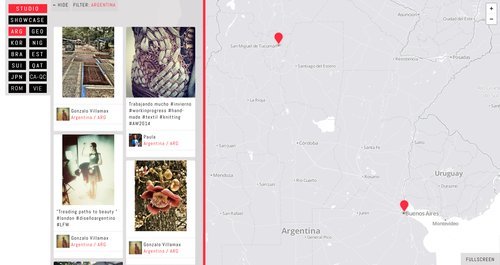
Argentinian designers’ work location and process, preceding their arrival to London for the IFS 2014. Courtesy of White Line Projects and Gareth Foote.
26 January 2014
by Niamh Tuft
White Line Projects is a collective of fashion curators - Daniel Caulfield-Sriklad, Fiona Mckay and Xenia Capacete Caballero - who explore digital practices in their work. In collaboration with developer Gareth Foote, they will be curating a digital platform for the International Fashion Showcase 2014 (IFS2014) which maps the experience of both designers and visitors experience of the showcase through their social media posts. The Studio to Showcase digital mapping project will chart the journey of individual designers from their home studio to UK showcase. Visitors to the exhibitions can also add their own posts and photographs by using the hashtag #IFS2014.
The Studio to Showcase project is an experiment in the crossover between personal worlds and professional lives. It aims to ultimately capture the designer’s voice and show how their cultural context has informed this all within one single online platform.
Whilst London Fashion Week traditionally presents designs in their finished form, recently there has been a shift in focus to explore the craftsmanship and technical skills that go into their making. Through the designers’ own tweets and instagrams, we can follow their journey from studio to industry showcase, and gain inspiring insight into how their personal environment inspires their design concepts.
The International Fashion Showcase (IFS) reflects how cultural context and heritage informs a significant part of the designer’s handwriting. As the IFS increases in size and profile, the Studio to Showcase digital mapping project captures its growing network of designers from outside the four main fashion capitals. It charts the migration of these designers, who retain links to their countries of origin whilst migrating to different creative hubs throughout the world.
In an attempt to process the information around us, mapping is increasingly used for constructing identity, politics and communications. Even from a purely aesthetic level, the nodes and codes representative of locations and countries are also embedded with meaning pertaining to micro geographies and cultures. Online, location is an essential connection with the real world, especially as we blur our physical journeys with that of the digital nomad, or observe other journeys as the contemporary digital flâneur. The combination of social media with mapping results in a new experience of multiple perspectives and relationships, redefining the world as our social playground.